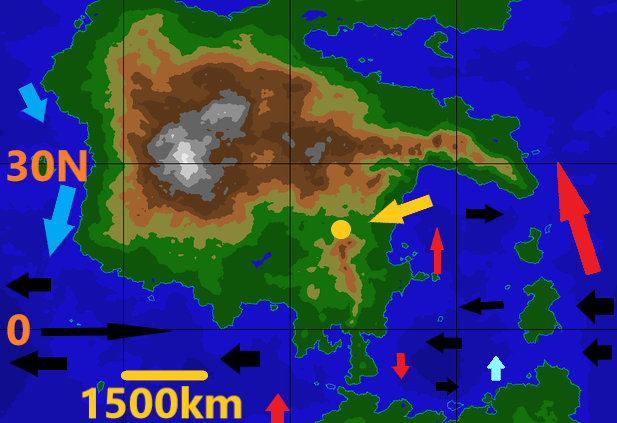On an Earth-like/Earth-size planet what would be the meteorological effect of a zone, maybe 300 kilometers across, about 20 degrees latitude, in the middle of a northern hemisphere large continental mass, which was permanently extremely hot e.g. average day temperature of over 80 degrees Celsius at its epicenter, the residue of an elemental spell gone wrong.
From a physics point of view the incoming heat comes from outside this plane. There is a parallel zone on the other side of the planet where heat is being lost at the same rate so the planet as a whole remains in stasis.
But, locally, I assume this heat would impact weather creating the equivalent of an extremely low pressure zone? Is this heat a magnitude greater in impact the sun has on our planet? Would that spin off low pressure areas that move? Which direction? Would there be rain/wind effects and how would that be impacted based upon distance from the oceans? It's only just north of the equator so I assume that moisture bearing air would be coming from its south?
Edit: so, based on my school level Geography lessons and your questions below I'll add what I hope would be useful clarifications.
1.There would be a coriolis effect that acted identically to that on Earth.
- There is a northern equatorial current flowing westwards which I'm assuming (a) would be deflected before it reaches the eastern edge of this continent and take warm water in a northerly direction. The sea area directly on the eastern coast would circulate within the confined space of the sea, vaguely like the Carribean current.
(b) On the western side of the continent it would be flowing away westwards sucking relatively cold water down that western coast

There would be a parallel southern equatorial current that also flows westward, although it would have relatively cooler waters feeding it.
This is only just and so to the north of a tropical zone.
In general I assume that, as on Earth, there are a set of prevailing winds that would be sucking humid tropical air towards the equator in a south-westerly direction? These might be wetter than normal because it would be hard for winds to also go north from the tropical zone because of the mountain range running roughly through latitude 30 degrees.
So, I think that it's the path of any storms generated by this that interests me the most. If this effect created a constant flurry of storms, and assuming enough moisture would they be of hurricane/cyclone type strength and where would it head off to? Easterly direction I think?
The impact on vegetation is more complex than I'd assumed initially, which is also quite interesting.


